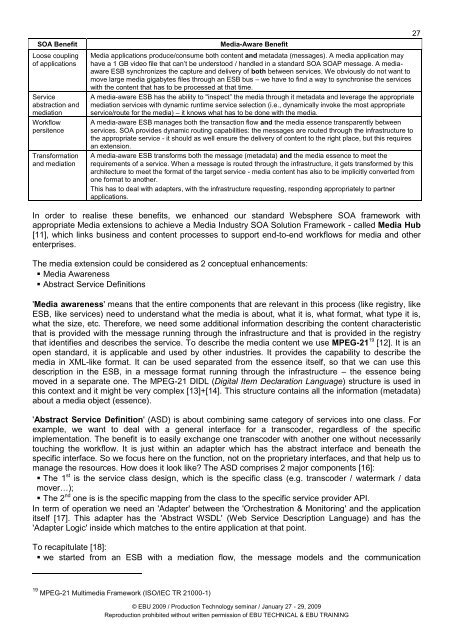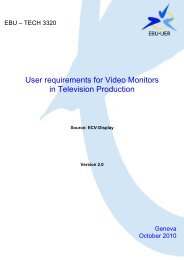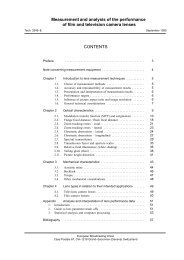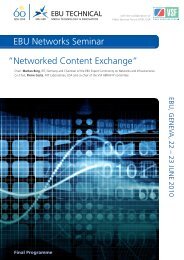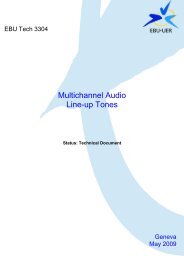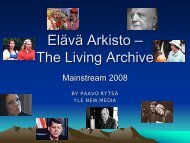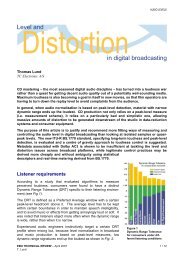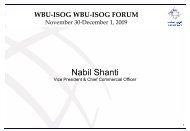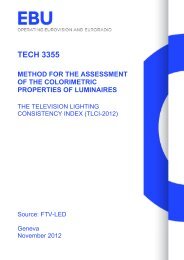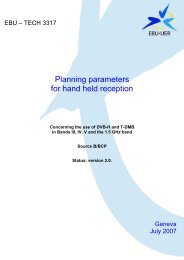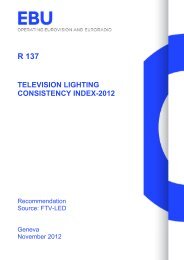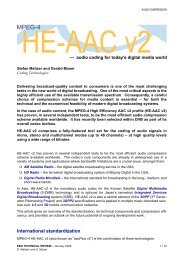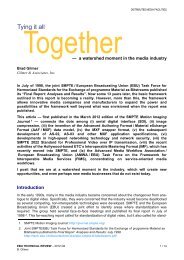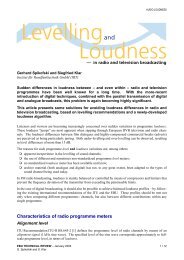Production Technology Seminar 2009 - EBU Technical
Production Technology Seminar 2009 - EBU Technical
Production Technology Seminar 2009 - EBU Technical
Create successful ePaper yourself
Turn your PDF publications into a flip-book with our unique Google optimized e-Paper software.
SOA Benefit Media-Aware Benefit<br />
Loose coupling<br />
of applications<br />
Service<br />
abstraction and<br />
mediation<br />
Workflow<br />
persitence<br />
Transformation<br />
and mediation<br />
Media applications produce/consume both content and metadata (messages). A media application may<br />
have a 1 GB video file that can‟t be understood / handled in a standard SOA SOAP message. A mediaaware<br />
ESB synchronizes the capture and delivery of both between services. We obviously do not want to<br />
move large media gigabytes files through an ESB bus – we have to find a way to synchronise the services<br />
with the content that has to be processed at that time.<br />
A media-aware ESB has the ability to "inspect” the media through it metadata and leverage the appropriate<br />
mediation services with dynamic runtime service selection (i.e., dynamically invoke the most appropriate<br />
service/route for the media) – it knows what has to be done with the media.<br />
A media-aware ESB manages both the transaction flow and the media essence transparently between<br />
services. SOA provides dynamic routing capabilities: the messages are routed through the infrastructure to<br />
the appropriate service - it should as well ensure the delivery of content to the right place, but this requires<br />
an extension.<br />
A media-aware ESB transforms both the message (metadata) and the media essence to meet the<br />
requirements of a service. When a message is routed through the infrastructure, it gets transformed by this<br />
architecture to meet the format of the target service - media content has also to be implicitly converted from<br />
one format to another.<br />
This has to deal with adapters, with the infrastructure requesting, responding appropriately to partner<br />
applications.<br />
In order to realise these benefits, we enhanced our standard Websphere SOA framework with<br />
appropriate Media extensions to achieve a Media Industry SOA Solution Framework - called Media Hub<br />
[11], which links business and content processes to support end-to-end workflows for media and other<br />
enterprises.<br />
The media extension could be considered as 2 conceptual enhancements:<br />
� Media Awareness<br />
� Abstract Service Definitions<br />
'Media awareness' means that the entire components that are relevant in this process (like registry, like<br />
ESB, like services) need to understand what the media is about, what it is, what format, what type it is,<br />
what the size, etc. Therefore, we need some additional information describing the content characteristic<br />
that is provided with the message running through the infrastructure and that is provided in the registry<br />
that identifies and describes the service. To describe the media content we use MPEG-21 19 [12]. It is an<br />
open standard, it is applicable and used by other industries. It provides the capability to describe the<br />
media in XML-like format. It can be used separated from the essence itself, so that we can use this<br />
description in the ESB, in a message format running through the infrastructure – the essence being<br />
moved in a separate one. The MPEG-21 DIDL (Digital Item Declaration Language) structure is used in<br />
this context and it might be very complex [13]+[14]. This structure contains all the information (metadata)<br />
about a media object (essence).<br />
'Abstract Service Definition' (ASD) is about combining same category of services into one class. For<br />
example, we want to deal with a general interface for a transcoder, regardless of the specific<br />
implementation. The benefit is to easily exchange one transcoder with another one without necessarily<br />
touching the workflow. It is just within an adapter which has the abstract interface and beneath the<br />
specific interface. So we focus here on the function, not on the proprietary interfaces, and that help us to<br />
manage the resources. How does it look like? The ASD comprises 2 major components [16]:<br />
� The 1 st is the service class design, which is the specific class (e.g. transcoder / watermark / data<br />
mover…);<br />
� The 2 nd one is is the specific mapping from the class to the specific service provider API.<br />
In term of operation we need an 'Adapter' between the 'Orchestration & Monitoring' and the application<br />
itself [17]. This adapter has the 'Abstract WSDL' (Web Service Description Language) and has the<br />
'Adapter Logic' inside which matches to the entire application at that point.<br />
To recapitulate [18]:<br />
� we started from an ESB with a mediation flow, the message models and the communication<br />
19 MPEG-21 Multimedia Framework (ISO/IEC TR 21000-1)<br />
© <strong>EBU</strong> <strong>2009</strong> / <strong>Production</strong> <strong>Technology</strong> seminar / January 27 - 29, <strong>2009</strong><br />
Reproduction prohibited without written permission of <strong>EBU</strong> TECHNICAL & <strong>EBU</strong> TRAINING<br />
27


